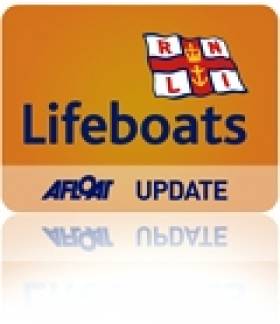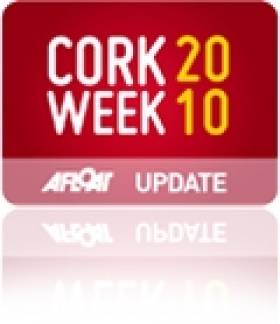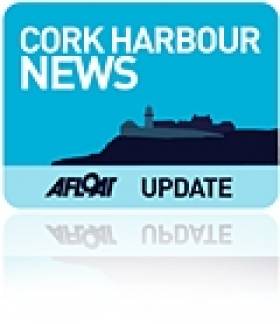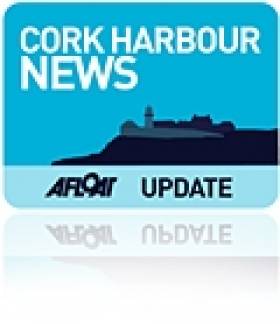Displaying items by tag: Crosshaven
Crosshaven RNLI Inshore Lifeboat undertook one of their longest distance services when they were tasked at 17.02 to a 10m Rib on passage from Falmouth to Baltimore, 12 miles south of Roches Point, when one of the crew suffered a suspected spinal injury. The Lifeboat transferred crewman Kevin Higgins onto the casualty vessel who assessed the injured crewman in radio consultation with the lifeboat Station Doctor. The lifeboat and RIB then proceeded to Crosshaven at a slow 5 knots arriving some 2 hours later. The casualty was then transferred to Cork University Hospital by ambulance. The helm on this Service was Ian Venner with Ritchie Kelleher.
Crosshaven Lifeboat Rescues 18-foot Yacht
Crosshaven RNLI Lifeboat went to the aid of an eighteen foot yacht on passage from the Kinsale area to Crosshaven this evening. The yacht with two persons on board suffered mechanical failure and was having trouble making way into a headwind.
Initially, the yacht was assisted by the motor Cruiser “Callie” who took them on initial tow and informed the Coastguard in Valentia who made the decision to Launch the Crosshaven lifeboat at 7pm. The Volunteer crew made up of Helm Con Crowley with Vincent Fleming and Ritchie Kelleher made their way to the rendezvous between the Cork Bouy and Rennies Point and relieved the motor cruiser of the tow. Crewman Ritchie Kelleher
Boarded the yacht and helped rig the tow for the 40 minute journey back to Crosshaven where the yacht was secured.
Cork Week Publishes Class Bands
Cork Week has published provisional class bands for July's regatta. So far there are seven entries in IRC super zero, 15 in class IRC zero, 17 in IRC one, 14 in IRC two, 21 in IRC 3, 19 in IRC four, 18 in IRC five, 18 in IRC 6 and 36 entries in white sails, sports boats and J109s. To find out who has entered for Cork Week 2010 this year, use the links below to check out each class.
|
PROVISIONAL CLASSES for CORK WEEK 2010 IRC Super 0
IRC 0
IRC 1
IRC 2
IRC 3
IRC 4
IRC 5
IRC 6
White Sail / Sports Boats / J109
|
Trad Sailing Fest for Cork
Crosshaven will play host to the annual Crosshaven Traditional Sail event on the weekend of June 18-20, with traditional boat races, currach competitions, and even a 'pirates and wenches' fancy-dress party.
Proceedings kick off on Friday June 18 with an 8pm opening ceremony at the Anchor Inn. Saturday's racing gets underway after a 12pm skippers briefing, with entertainment and food in the village throughout the day and more of the same on Sunday. The festival has, in the past, attracted a wide variety of Gleoiteogs and other traditional craft, and more information is available on www.crosshaventradsail.com
Fire at Cork Boatyard Extinguished
Three units of Cork Fire Brigade dealt with a fire that broke out close to a diesel tank in a boatyard in Crosshaven today. No one was hurt in the blaze that broke out at lunch time and there was no damage to boats. Containers stored in the yard near a travel lift have been damaged, according to bystanders.
Cork Week: The World's Top Fun Regatta
Cork Week – The World's Top Fun Regatta
Since 1978 Cork Week has been setting the bar for Irish Sailing and Afloat Magazine has documented the growth of the biennial event over the past 30 years to the stage today where it is widely regarded as one of the world's top regattas. For all the latest news and updates on Cork Week click here.
Take a small sleepy fishing village. Add water (well, the Atlantic Ocean) and old-fashioned Irish charm. Stir in seven bars, three restaurants, 50 bands, 400 performers and 180 hours of entertainment. Bake in warm sunshine for one week every two years. Sprinkle with 7,000 high-earning visitors.
This is the recipe for success at Cork Week regatta – an icon of Ireland's summer sport that has a bigger reputation overseas than it has at home.
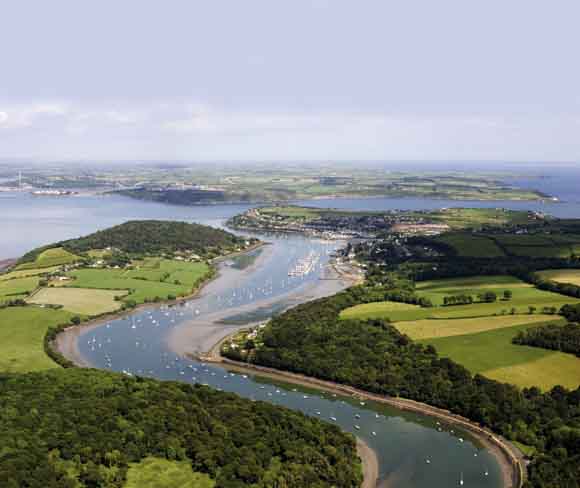
Above: Looking south towards Crosshaven. Photo: Bob Bateman
Competitors come from as far away as the US, Hong Kong, Australia, France, Germany and Belgium. 2006's regatta attracted first time entries from the Philippines, South Africa, Italy and Sweden but the mainstay of the biennial event is a huge representation from England, Scotland and Wales.
Cork Week, of course is not the only regatta of its kind in the world and many copycat events have sprung up across Europe. But Cork continues to have a special mix that lives up to its billing as the number one fun regatta in the world.
For a typical 450 entries, 80% of them would come from overseas, and they are heading here to race but also for the fun.
In many respects Cork Week, when it first started in 1986, took its inspiration from the success of Cowes Week on the Solent but from the beginning Royal Cork Yacht Club (RCYC) organisers wanted to do more than ape a British event.
They saw a gap in the regatta market and took a bold decision to do away with convention and rewrite the rules for sailing regattas. It sounds cliched some 23 years later but they wanted to produce a regatta that was run by sailors for sailors.
What this actually meant was they set about banning professional sailors from attending Cork at a time when regattas across Europe were suffering from the invasion of paid-to-sail crews. It was a situation that left amateur skippers and crews, representing the majority of the sailing community, tired of heading home without any silverware.
The plan was risky, of course, because pros were an influential bunch required to establish the regatta as a credible venue. Banning them was especially problematic for a remote venue on the outskirts of Europe where the high costs of transporting crew and equipment could have kept many away.
But the crews didn’t stay away and the ‘no-pro’ rule, as it became known, has worked in Cork’s favour. Amateur sailors embraced the idea and owners return to Crosshaven year after year to race against each other for a week of Corinthian fun.
Cork went one better by going back out to the professional circuit and inviting pros to a special restricted class within the week where they could race with each other.
In 2004, for example, it attracted some real professional glamour. American Roy Disney came to town, as did the German billionaire Hasso Plattner, both racing massive Z-86 racing machines around Cork harbour. It was a show stopper and put the glitz into Cork.
It hasn't all been plain sailing however. The Cork week organisation has had its difficulties. Four years ago the host club, the RCYC was so intent on having a good time that it lost money on the enterprise. Thankfully it’s now on a firm financial footing again and the event looks stronger than ever.
Around the same time, many Irish sailors began to think that Cork Week had become just the ‘The Solent on tour’.
They were turned off by the high prices of local accommodation for the week. Dublin sailors complained that the successful Crosshaven formula had been over cooked. They resented paying up to 500 Euro to share a bedroom for the week.
Thankfully that too has been ironed out with a bigger range of accommodation now on offer.
But perhaps in the crush most Irish sailors forgot to appreciate just what they have on their own doorstep. Nowhere was this point more clearly made than in early June when the world’s top offshore sailors called in unexpectedly to our south coast.
They came principally in search of wind in leg eight of the Volvo Round the World race. They found little wind, unusually, but before they left they wrote prose worthy of a Failte Ireland copywriter.
In his log, navigator Simon Fisher wrote: “Our day started sailing in and out of the mist rolling down off the hills and, as the sun rose and the mist burnt off, it gave way to spectacular views of rolling green hills and a weather-beaten rocky coastline. With castles and towers stationed on each headland, it gives you the feeling of sailing through a scene out of Lord of the Rings.”
With endorsements like that, it’s easy to see why Crosshaven will teem again with sailors and supporters for a festival of sailing that’s more like Galway Races on water than a regular Irish sailing regatta.
Although Cork Week's not all about rubbing shoulders with serious money, it is hard to ignore the economic value of the event.
Putting a figure on it can be difficult but Cork Week chairman Ian Venner reckons it is worth 10 million Euro to the local economy. It's like Ireland –v– England at Lansdowne road in an otherwise sleepy fishing village.
You can read Cork Week's own history of the event here.



























